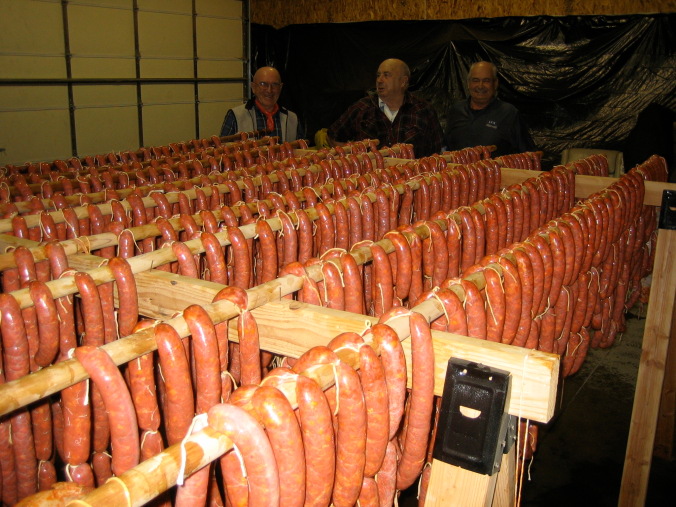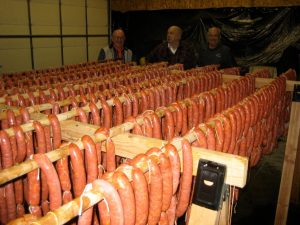About the time I went off to college, my dad started making his own chorizo. He’d send me off with packages of frozen sausage – at the time, he’d pack them in a cut up milk jug filled with water and freeze them. So, I’d have rows and rows of chorizo that I’d broken free from the ice laid out on my dorm-room desk to dry. I got more than a few odd looks, but they were wonderful – more tangy than the ones we’d get from the store made by Gem Meat Packing. My dad would always give me a hard time, teasing me about how I could love chorizo so much when they were full of peppers – I hate the taste of peppers, but I never could taste it in the chorizo.
- Chorizo – txorizo in Euskara – is a pork sausage that is typically cured and dried. It is common to the whole Iberian peninsula – Portugal and Spain. In Spain, there are literally hundreds of local varieties and for a sausage to be called chorizo, it must contain both garlic and paprika (specifically pimentón). Of course, the paprika gives it the mild spiciness and red color that make it stand out. Depending on the variety, it can either be eaten as is – sliced and served – or after cooking (baked, fried, grilled).
- Chorizo de Pamplona is a variant that is common in Nafarroa. It is distinguished by the more finely chopped meat and the combination of minced pork and beef as well as bacon. It is typically much thicker than other chorizos and is often sliced and used in sandwiches. Chorizo de Pamplona takes about 3 months to cure. The drier climate of Pamplona is essential to this process.
- Txistorra is another variant of chorizo that is from the Basque Country and Aragon. It tends to be thinner than regular chorizo, only about one inch thick. It has a faster curing time, needing as little as 24 hours to set and 2-3 days to dry. It is thought that it has its origins in Gipuzkoa where it was made with left over pig meat – in some places it is called birika, which means lung in Basque, as it was made with pig’s lung. It is cooked before serving and is usually served as an accompaniment to other foods or as a pintxo. It is particularly popular during the Feria of Santo Tómas. A common dish is txistorra (or txorizo) with fried potatoes and eggs.
- Chorizos (or chur-dee-shows as they are often called locally) are staples of the Basque festivals in the US west. In fact, I’d go so far to say that you can’t have a Basque festival without chorizo. Down at the Basque Block in Boise, there are “hotdog” stands that sell chorizo (or at least there used to be…) And, because of the popularity of Basque-style chorizo in the region, there are a number of producers: Ansots, Falls Brand, and Hill’s Premium Meats (using the recipe from Gem Meat Packing) are just a few.
Primary sources: Chorizo, Wikipedia; Chistorra, Wikipedia; Chorizo de Pamplona, Wikipedia; Chistorra, Wikipedia
Discover more from Buber's Basque Page
Subscribe to get the latest posts sent to your email.




This is so fascinating. I love chorizo but knew so little about it!
Txorizo! Baii! Gogoko dut!
What a great article! After living in Mexico’s Yucatan Peninsula for nine years, we became attached to Mexican
chorizo. We cannot wait to try some chorizo in the Basque Country.
Freaking Fantastic!
I wish I had a BASQUE chrorizo to dry out in my dorm room at college.
We did have a Korean orphan bring a big bottle of Kimchi.
We had to put it in the hall.
It stunk so much.
We also had many fabulous things,
including boxing matches in the hallway.
I caught the starter with the gloves,
and was only one to toss the steak knives into the custodians wooden door in late PM.
¡VIVA mi BASQUE fußball teams!
THE ATHLETIC CLUB
KING’s SOCIETY
BILBAO (before there was Rocky, their was BILBAO)
ALAVÉS
about to make a tixmatio
Saw this video about the BASQUE strongmen!
&
Women!!
Ohhhhh….
https://m.youtube.com/watch?v=vck32S27RmM